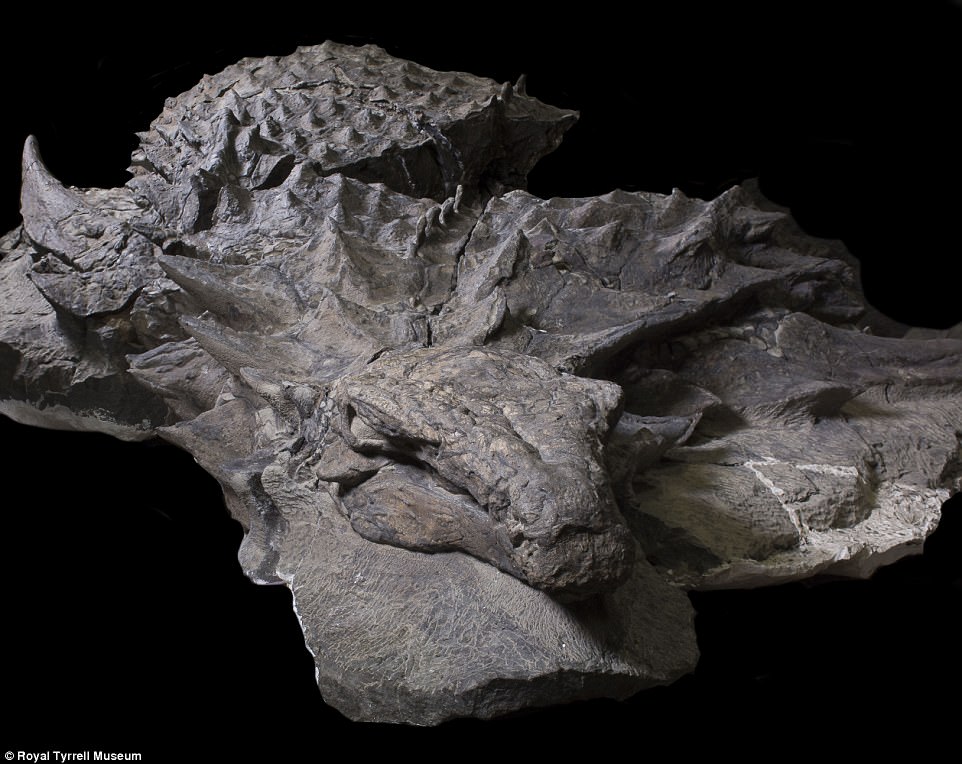Robert sent in two links – www.dailymail.co.uk/sciencetech/article-4500220/Dinosaur-fossil-preserve… … and www.nationalgeographic.com/magazine/2017/06/dinosaur-nodosaur-fossil-dis… … with the comment, the dinosaur is so well preserved that it might have been walking around a couple of weeks ago, quoting a paleontologist, adding, 'was it really 110 million years old?' However, reading on we learn it was found in a mine in northern Alberta in 2011 and is about to go on show in a museum (hence the news value). It feature two 20 inch spikes growing out of its shoulders and had armour plating in order to deter predators. It was a plant eating beast – the equivalent, I suppose, of the modern rhinoceros.
 According to National Geographic magazine, the fossil is the best preserved dinosaur of this species. It took 6 years of work to ensure the beast within a 2500lbs lump of earth was brought out intact. It has skin and armour and is complete from snout to hip (but it's rear end is missing). The mine in question is basically a large pit 17 miles north of Fort McMurray in Alberta. The prize appears to be sand laced with bitumen. This has it own fossil assemblage, primarily marine in nature, plants and creatures that live in the sea. Fossil wood and the occasional petrified tree stump are often encountered but not the bones of dinosaurs. What was Nodosaur doing in a marine environment? – the so called inner seaway of the Cretaceous era. Was it really an inland sea that thrived over millions of years or could we have evidence of a massive tsunami wave that swept northwards into the heart of Canada? The problem with the latter idea is that an animal would not have been preserved whole, or nearly whole, but would have been disassembled by the energy in play during a tsunami event. One might suggest it could be evidence of a shift in the geoid, a realignment of earth's water bodies. Having said that, in order for the dinosaur to be buried instantaneously, the preservation of its skin suggests a sudden entombment, some kind of natural catastrophe appears relevant – if only an earthquake or some such thing.
According to National Geographic magazine, the fossil is the best preserved dinosaur of this species. It took 6 years of work to ensure the beast within a 2500lbs lump of earth was brought out intact. It has skin and armour and is complete from snout to hip (but it's rear end is missing). The mine in question is basically a large pit 17 miles north of Fort McMurray in Alberta. The prize appears to be sand laced with bitumen. This has it own fossil assemblage, primarily marine in nature, plants and creatures that live in the sea. Fossil wood and the occasional petrified tree stump are often encountered but not the bones of dinosaurs. What was Nodosaur doing in a marine environment? – the so called inner seaway of the Cretaceous era. Was it really an inland sea that thrived over millions of years or could we have evidence of a massive tsunami wave that swept northwards into the heart of Canada? The problem with the latter idea is that an animal would not have been preserved whole, or nearly whole, but would have been disassembled by the energy in play during a tsunami event. One might suggest it could be evidence of a shift in the geoid, a realignment of earth's water bodies. Having said that, in order for the dinosaur to be buried instantaneously, the preservation of its skin suggests a sudden entombment, some kind of natural catastrophe appears relevant – if only an earthquake or some such thing.
The Nodosaur was 18 feet in length and weighed around 3000lbs. Researchers think it was fossilised whole but only the front half has survived. Was it disarticulated when buried – broken asunder. Tossed in water. We are told that in the Cretaceous period Alberta was semi tropical and an inland seaway covered much of inner North America. Evidence of marine life is abundant. We also learn that a relative of the Nodosaur, an Ankylosaur, has been found more recently in Montana – entombed in a 35,000lb block of stone.
